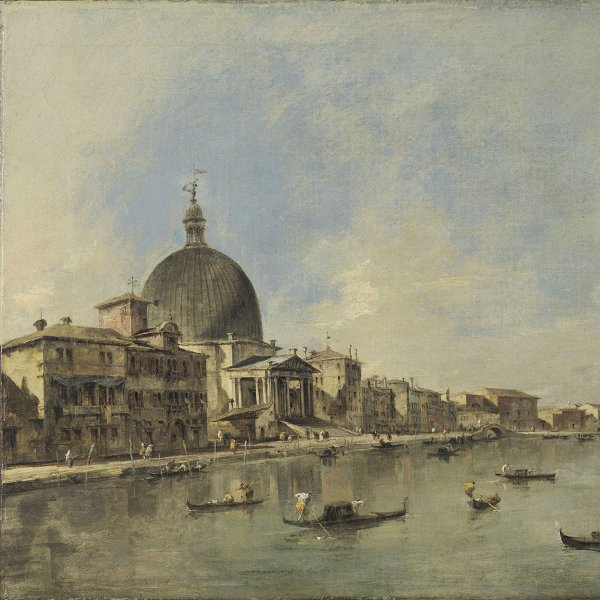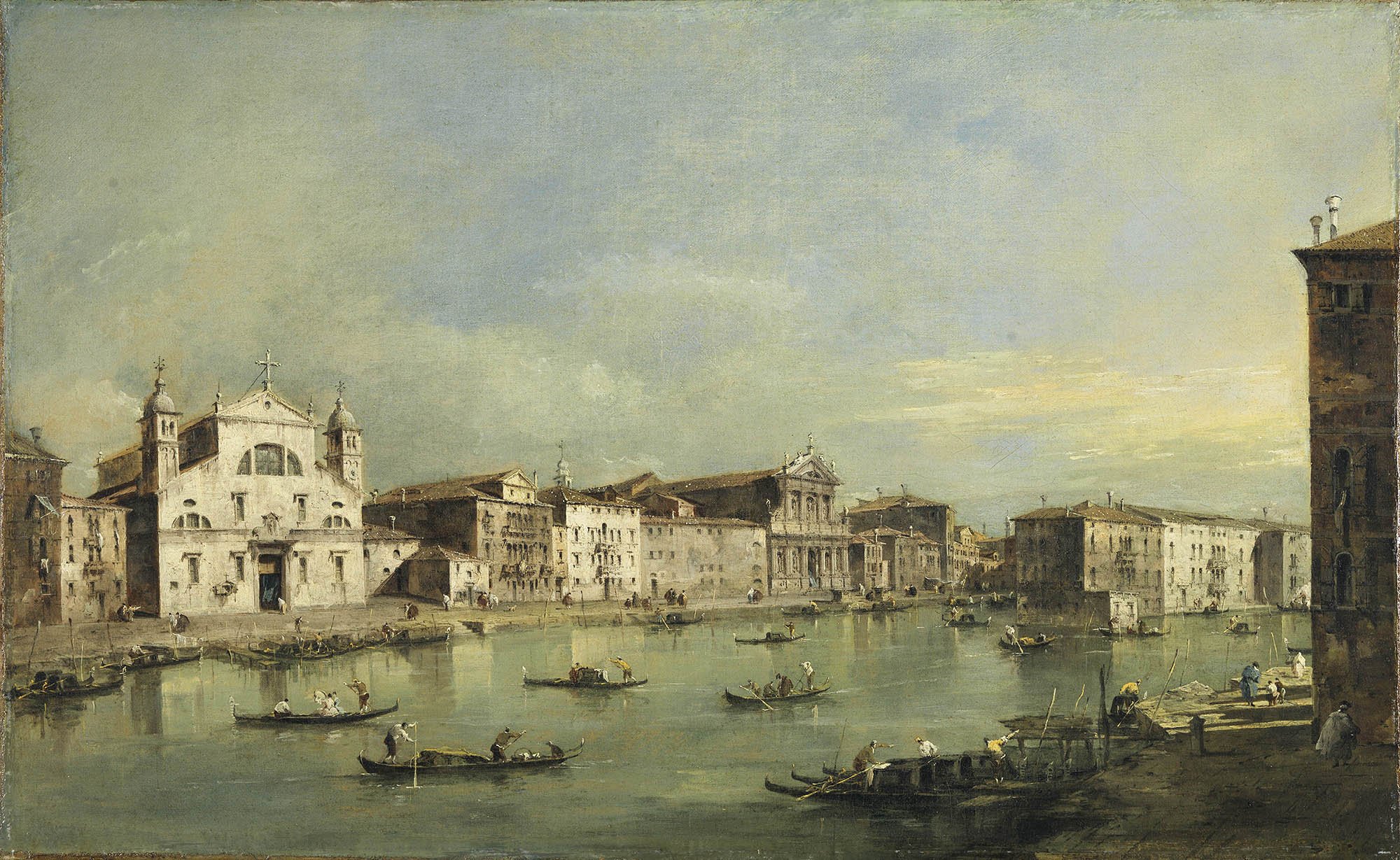The Grand Canal with Santa Lucia and Santa Maria di Nazareth
ca. 1780
Oil on canvas.
48 x 78 cm
Museo Nacional Thyssen-Bornemisza, Madrid
Inv. no.
174
(1934.6
)
Room 17
Level 2
Permanent Collection
Francesco Guardi was the brother of Gianantonio and a painter of vedute and capricci. Related to Giambattista Tiepolo, who was his brother-in-law, he trained in the family circle and worked with his brother who was a figure painter. Guardi established himself as an independent painter on the death of his brother Gianantonio in 1760 and specialised in views. His early works in this genre reflect the influence of Canaletto in important details such as the figures and other elements to be seen in his panoramic compositions. During the 1770s Guardi evolved his own style in which colour and light were crucial elements, becoming a fully mature artist in the 1780s. Guardi also chronicled major events in the Venetian Republic, such as his paintings of the visit of the Condi dei Nord, the Grand Duke Paul of Russia and Maria Feodorovna, commissioned by the Republic to commemorate the visit (now divided between the Alte Pinakothek, Munich, and various private collections). Other comparable series depict the visit of Pope Pius IV in a set of four canvases, and the fire at San Marcuola of 1784.
The present pair of canvases was in the Danbuz collection on the Isle of Wight then belonged to Leonard Gow in Dumbartonshire. The two views entered the Rohoncz collection in 1934 and are first recorded in the literature in 1937 by Rudolf Heinemann in the catalogue of the Collection. Both paintings were included in the monographic exhibition on the Guardi held in Venice in 1965, whose catalogue was written by Pietro Zampetti.
The two canvases depict part of the Grand Canal seen from one bank. In San Simeone Picco and Santa Lucia the water of the canal occupies a large areas of the canvas, extending across the entire lower edge and into the distance where the two banks appear to come closer together as they recede. The line of buildings on the left is dominated by the great dome with its lantern of San Simeone Piccolo, a central-plan church inspired by the Pantheon in Rome and designed in the 18th century by Giovanni Scalfarotto. Guardi emphasised the large flight of entrance steps of the church and its portico. Next to it on our left is the palazzo Foscari-Contarini while on the right bank is the church of Santa Lucia, located on an area of the canal that was redeveloped in the 19th century. The church was demolished with some of its surrounding buildings to make room for the railway station. A number of other versions of this view are known, including one in the Akademie in Vienna and another in the Philadelphia Museum of Art, as well as a drawing that appeared at auction in New York in early 1990, consigned from a private collection.
In the second canvas, which is the pendant to this one and completes the view, the pronounced line of the bank on the left leads us into the composition. The first building is the church of Santa Lucia, followed by a series of constructions of similar height including the now demolished palaces of Lion-Cavazza and Bragadin-Vescovi, leading the eye to Santa Maria di Nazareth, better known in the present day as Santa Maria degli Scalzi. The church was designed by Baldassare Longhena with an ornate façade completed by Giuseppe Sardi. Among the versions of this canvas, one of the best is again in the Akademie in Vienna. There is a drawing for this composition in the Ten Cate collection in Almelo.
The two canvases date to Guardi’s mature period around 1780 and are outstanding examples of his work. In paintings of this type the land seems to be subsidiary to the water and sky, which almost blend together and occupy significant proportions of these sweeping panoramas. Guardi used a loose type of brushstroke to delineate the various elements in his compositions, in which the boats and figures provide movement and colour, animating scenes in which light and atmospheric effects dilute the forms to magical effect.
Mar Borobia
The present pair of canvases was in the Danbuz collection on the Isle of Wight then belonged to Leonard Gow in Dumbartonshire. The two views entered the Rohoncz collection in 1934 and are first recorded in the literature in 1937 by Rudolf Heinemann in the catalogue of the Collection. Both paintings were included in the monographic exhibition on the Guardi held in Venice in 1965, whose catalogue was written by Pietro Zampetti.
The two canvases depict part of the Grand Canal seen from one bank. In San Simeone Picco and Santa Lucia the water of the canal occupies a large areas of the canvas, extending across the entire lower edge and into the distance where the two banks appear to come closer together as they recede. The line of buildings on the left is dominated by the great dome with its lantern of San Simeone Piccolo, a central-plan church inspired by the Pantheon in Rome and designed in the 18th century by Giovanni Scalfarotto. Guardi emphasised the large flight of entrance steps of the church and its portico. Next to it on our left is the palazzo Foscari-Contarini while on the right bank is the church of Santa Lucia, located on an area of the canal that was redeveloped in the 19th century. The church was demolished with some of its surrounding buildings to make room for the railway station. A number of other versions of this view are known, including one in the Akademie in Vienna and another in the Philadelphia Museum of Art, as well as a drawing that appeared at auction in New York in early 1990, consigned from a private collection.
In the second canvas, which is the pendant to this one and completes the view, the pronounced line of the bank on the left leads us into the composition. The first building is the church of Santa Lucia, followed by a series of constructions of similar height including the now demolished palaces of Lion-Cavazza and Bragadin-Vescovi, leading the eye to Santa Maria di Nazareth, better known in the present day as Santa Maria degli Scalzi. The church was designed by Baldassare Longhena with an ornate façade completed by Giuseppe Sardi. Among the versions of this canvas, one of the best is again in the Akademie in Vienna. There is a drawing for this composition in the Ten Cate collection in Almelo.
The two canvases date to Guardi’s mature period around 1780 and are outstanding examples of his work. In paintings of this type the land seems to be subsidiary to the water and sky, which almost blend together and occupy significant proportions of these sweeping panoramas. Guardi used a loose type of brushstroke to delineate the various elements in his compositions, in which the boats and figures provide movement and colour, animating scenes in which light and atmospheric effects dilute the forms to magical effect.
Mar Borobia






